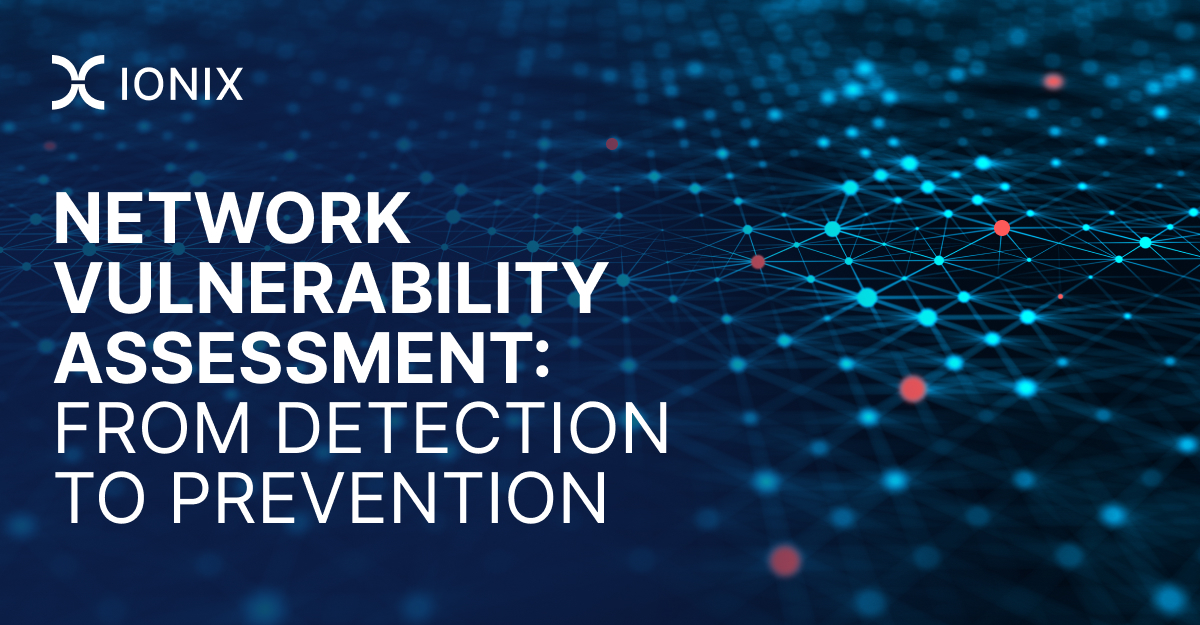Network Vulnerabilities Assessment: Benefits & Steps

Securing a network against cyber threats requires a thorough understanding of its vulnerabilities. A vulnerability assessment is a detailed process aimed at identifying, evaluating, and ranking potential weaknesses within a network setup. From examining configurations to assessing access controls, this assessment dives deep into every aspect of the network to uncover areas of vulnerability. By providing practical insights, organizations can strengthen their defenses, allocate resources wisely, and stay ahead of evolving cyber risks. In this article, we’ll explore the ins and outs of network vulnerability assessments, including their benefits, methods, tools, and the crucial role of prioritizing risks in safeguarding against cyber threats.
In this article
What Is a Network Vulnerability Assessment?
A network vulnerability assessment is a systematic process aimed at identifying, quantifying, and prioritizing vulnerabilities within a network infrastructure. It involves evaluating various components of the network and its attack surface, including devices, systems, applications, and configurations, to uncover potential weaknesses that could be exploited by malicious actors. This assessment typically includes activities such as scanning for vulnerabilities, analyzing security configurations, and assessing the overall security posture of the network. The goal of a network vulnerability assessment is to provide organizations with actionable insights into their network security risks, enabling them to prioritize remediation efforts and strengthen their overall cybersecurity defenses.
What Does a Vulnerability Assessment Look For in a Network?
A vulnerability assessment in a network seeks to identify and analyze various security weaknesses and vulnerabilities that could compromise the integrity, confidentiality, or availability of network resources. Here are some common network vulnerabilities that an assessment typically looks for in a network:
- Misconfigurations:
Assessing network configurations to identify settings that are not aligned with security best practices, such as open ports, weak encryption settings, or default passwords.
- Weak Passwords:
Identifying passwords that are easily guessable or commonly used, as well as accounts with default or unchanged credentials that could be exploited by attackers.
- Unpatched Systems:
Identifying systems that have not been updated with the latest security patches and fixes, leaving them vulnerable to exploitation by attackers leveraging known vulnerabilities.
- Vulnerabilities in Applications:
Analyzing networked applications for security flaws, such as input validation errors, buffer overflows, or insecure coding practices that could be exploited by attackers.
- Access Control Issues:
Evaluating access control mechanisms to identify unauthorized access paths or permissions that could be exploited by attackers to gain unauthorized access to network resources.
- Network Architecture Weaknesses:
Assessing the overall network architecture for weaknesses, such as single points of failure, lack of segmentation, or inadequate network monitoring and logging capabilities.
Benefits of Network Vulnerability Assessment for Your Organization:
Regular network cybersecurity assessments provide essential benefits for modern organizations grappling with cybersecurity threats. Serving as proactive measures, these assessments safeguard organizational assets, enhance defenses, and mitigate the risk of cyber attacks.Let’s dive deeper into the significant advantages that vulnerability assessments of a network offer:
- Network Insight:
Network vulnerability assessments offer vital insights into organizational security by systematically evaluating network components, configurations, and policies. This heightened awareness empowers stakeholders to make informed decisions about cybersecurity strategies, resource allocation, and risk mitigation.
- Incident Response Readiness:
By proactively identifying vulnerabilities, organizations enhance their incident response preparedness. This proactive approach allows for swift and effective responses to potential cyber threats, enabling the development of robust incident response plans and streamlined procedures to mitigate the impact on business operations.
- Compliance Assurance:
Conducting network vulnerability assessments helps organizations ensure compliance with regulatory requirements and industry standards. By identifying vulnerabilities and implementing necessary remediation measures, organizations demonstrate their adherence to security best practices and regulatory mandates, thus mitigating legal and reputational risks.
- Resource Optimization:
Efficient allocation of resources is facilitated by prioritizing remediation efforts based on identified vulnerabilities. By focusing on critical vulnerabilities first, organizations optimize resource utilization, maximizing the effectiveness of remediation efforts while minimizing costs and operational disruptions.
- Continuous Improvement:
Network vulnerability assessments serve as a foundation for continuous improvement in cybersecurity practices. By regularly evaluating network security posture, organizations can identify trends, patterns, and areas for improvement, allowing for ongoing refinement of security strategies and measures to adapt to evolving threats and challenges.
Types of Network Vulnerability Assessments:
Each type of vulnerability assessment of a network serves a specific purpose and offers unique insights into network security vulnerabilities. Network vulnerability assessments can take various forms, including:
- Internal Assessments:
Internal network vulnerability assessments focus on evaluating the security posture of internal network resources like servers, workstations, and databases within the organizational perimeter. Leveraging insider access, these assessments identify vulnerabilities and security gaps in critical infrastructure components. They provide insights into insider threats, misconfigurations, and exploitable vulnerabilities.
- External Assessments:
External assessments, also called perimeter assessments, scrutinize external-facing assets such as web servers, firewalls, and VPN gateways for vulnerabilities. Simulating attacks from external threat actors reveals potential entry points and vulnerabilities that attackers could exploit to breach the network perimeter. These assessments bolster external defenses and mitigate the risk of unauthorized access.
- Authenticated Assessments:
Authenticated assessments use privileged credentials or insider access to conduct vulnerability scans. They offer deeper insights into system and application security posture, including vulnerabilities inaccessible to unauthenticated scans. These assessments provide a comprehensive view, aiding in the effective prioritization of remediation efforts.
- Unauthenticated Assessments:
Unauthenticated assessments simulate attacks from external threat actors without requiring privileged credentials. They identify vulnerabilities accessible to unauthorized users, enhancing understanding of potential entry points and weaknesses from an external perspective. These assessments help organizations strengthen their security posture against external threats.
- Passive Assessments:
Passive assessments monitor network traffic and analyze data packets to identify vulnerabilities and security threats. Operating without actively probing network devices, they observe network activity to detect anomalous behavior and potential risks. These assessments offer insights into network vulnerabilities and security risks without directly interacting with network resources.
- Active Assessments:
Active assessments involve actively scanning and probing network resources for vulnerabilities and security weaknesses. Simulating attacks from internal and external threat actors, they use scanning tools to identify exploitable vulnerabilities. These assessments provide actionable insights for prioritizing remediation efforts and fortifying network defenses against potential cyber threats.
Steps in Running a Network Vulnerability Assessment:
Performing a network vulnerability assessment is crucial for protecting organizational assets from cyber threats. Organizations use a structured network vulnerability assessment methodology to manage vulnerabilities, guiding them through key steps from asset discovery to remediation. By following this network vulnerability assessment template, they systematically uncover any potential weaknesses, prioritize risks, and enhance their security posture.This involves several key steps:
- Asset Discovery:
Asset discovery involves systematically uncovering all internet-facing assets within the organization. This includes web and mobile applications, cloud storage, and email servers, aiming to establish a comprehensive inventory of digital assets for a thorough understanding of the organization’s online presence.
- Asset Attribution:
Accurate asset attribution is crucial to knowing whether an asset belongs to the organization and understanding the criteria used for attribution. Utilizing machine learning at scale reduces false positives and provides greater control and clarity of the attack surface.
- Inventory and Classification:
After discovery and attribution, assets are systematically categorized and labeled based on types, technical features, and business importance. This step is essential for each organization to better understand and manage its attack surface.
- Risk Assessment:
Risk scoring and security ratings evaluate each asset for vulnerabilities and assign security ratings. This quantifies the risk level of each asset, guiding where security efforts should be focused.
- Risk Prioritization:
Prioritizing risks ensures focusing on the most critical ones. By quickly identifying the top risks that pose the most danger, organizations can respond effectively. Prior steps aid in this prioritization, forming the basis for decision-making on high and low-priority risks.
- Continuous Security Monitoring:
Often requiring the assistance of autonomous tools, continuous security monitoring involves vigilance over digital assets and regular monitoring for new vulnerabilities and changes in the attack surface and asset configurations. Automated vulnerability discovery ensures prompt identification and resolution of potential security threats.
- Remediation and Mitigation:
In this phase, vulnerabilities, misconfigurations, and security posture issues identified earlier are addressed. Remediation involves direct actions like patching, while mitigation refers to strategies to reduce the impact of unresolved vulnerabilities, ensuring ongoing security and resilience.
Network Vulnerability Assessment Tools:
Network vulnerability assessment tools are essential components in the arsenal of cybersecurity professionals tasked with safeguarding organizational networks against potential threats. These tools provide a systematic approach to identifying, analyzing, and mitigating vulnerabilities that could be exploited by malicious actors. These tools include:
- Vulnerability Scanners:
Automated tools that scan for known vulnerabilities in network devices and applications.
- Network Mapping Tools:
Visualize network topology to identify potential vulnerabilities.
- Configuration Auditing Tools:
Assess security configurations of network devices for compliance with standards.
- Exploit Frameworks:
Simulate cyber attacks to test security controls and identify weaknesses.
- Patch Management Systems:
Automate deployment of security patches to address vulnerabilities.
- Reporting and Analysis Tools: Generate detailed reports and analytics for informed decision-making.
Prioritizing Network Vulnerability Remediation:
In network vulnerability scanning, prioritization is key. With IONIX’s Attack Surface Management Platform organizations can focus on addressing the most urgent and exploitable risks efficiently, bolstering their cybersecurity posture.
- Risk Prioritization:
IONIX employs a robust risk prioritization methodology known as ‘Connective Intelligence’ to focus on vulnerabilities with the highest potential impact. By assessing vulnerabilities across asset importance, business context and dependencies, organizations gain insight into the most critical risks.
- Exploitable Risks:
IONIX prioritizes vulnerabilities based on exploitability, flagging immediately exploitable threats for remediation. This proactive approach addresses critical risks like dangling DNS records, exposed storage, and other issues promptly.
- Threat Intelligence Integration:
IONIX integrates threat intelligence seamlessly, monitoring the deep and dark web for potential threats. This ensures prompt identification and mapping of sensitive data leaks, facilitating prioritization for remediation.
Aligning remediation efforts with IONIX’s risk prioritization framework allows organizations to optimize vulnerability management, focusing on critical vulnerabilities and minimizing the impact of cyber threats.
Preventing Network Vulnerabilities:
Beyond detection, prevention is key to mitigating network vulnerabilities. Organizations can implement preventive measures, such as regular patch management, network segmentation, access controls, encryption, and employee training, to reduce the likelihood of successful cyber attacks. In an increasingly interconnected digital landscape, network security vulnerability assessment plays a critical role in safeguarding organizational assets and data against cyber threats.
By understanding the significance of vulnerability assessment, adopting best practices, leveraging automated vulnerability detection techniques, and implementing preventive measures, organizations can strengthen their network security posture and mitigate the risk of cyber attacks. Additionally, by utilizing IONIX’s risk prioritization framework, organizations can efficiently tackle the most urgent vulnerabilities, improving their cybersecurity stance and reducing the impact of potential cyber threats.






